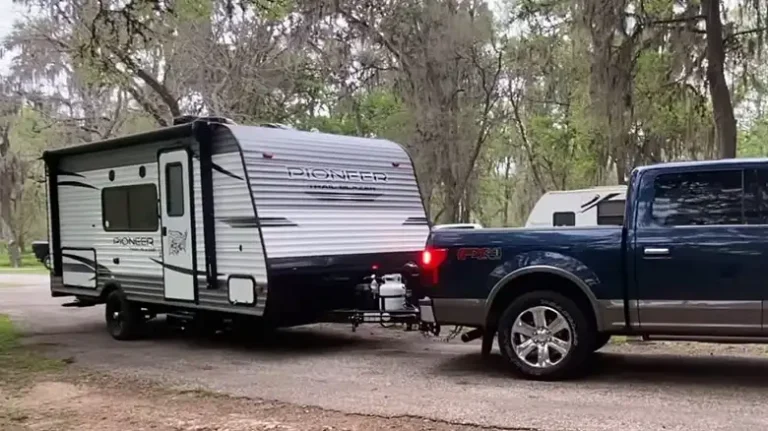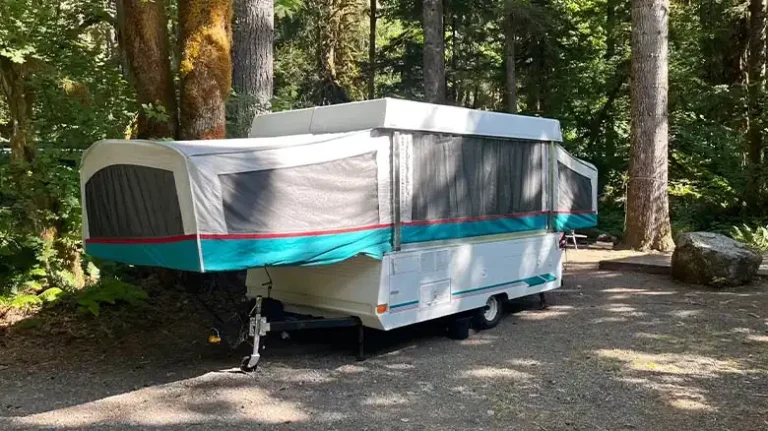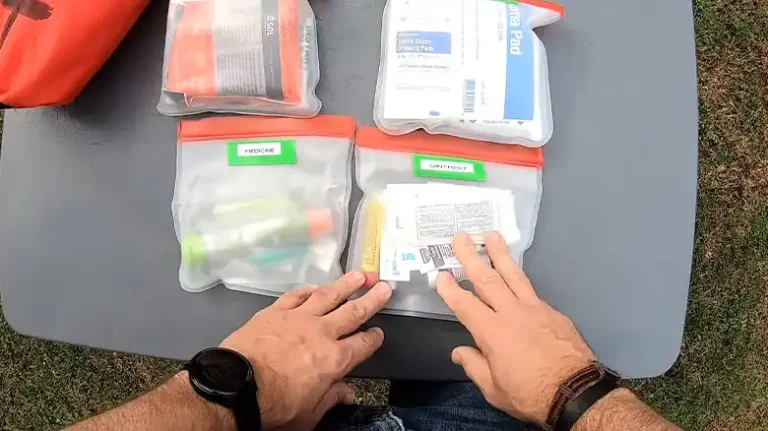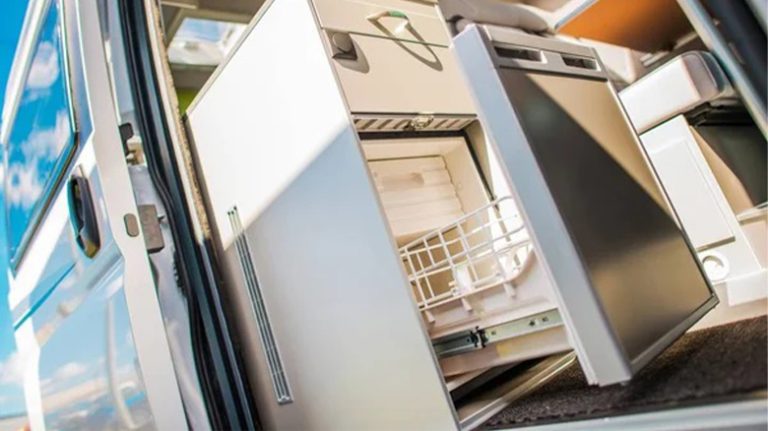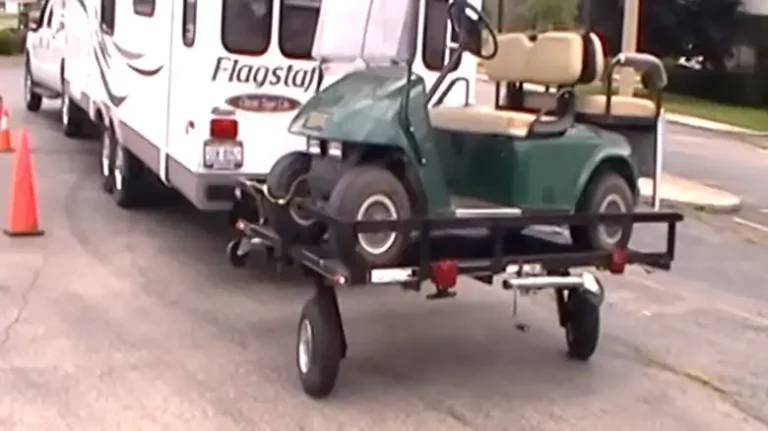How to Put a Truck Camper on a Trailer | Helpful Guide
Truck campers provide living space on truck beds for adventure. Trailers let you transport larger campers to expand travel options. Loading a camper properly on a trailer takes care and technique. Done right, you can safely haul your home anywhere.
The key steps involve finding a trailer matched to your camper’s size and weight capacity. Measurements must be taken to center the camper properly on the trailer. Specialized tie-down systems are used to lock the camper in place to prevent shifting during transport. When done correctly, you gain expanded options to explore while still enjoying the familiar comforts of your camper.
Towing a loaded camper trailer requires focus on safety. Proper weight distribution, adequate braking, increased visibility, and cautious driving are all essential. But with the right precautions, you can safely bring your cozy camper to any adventure. Let’s look at the step-by-step process for how to put a truck camper on a trailer.
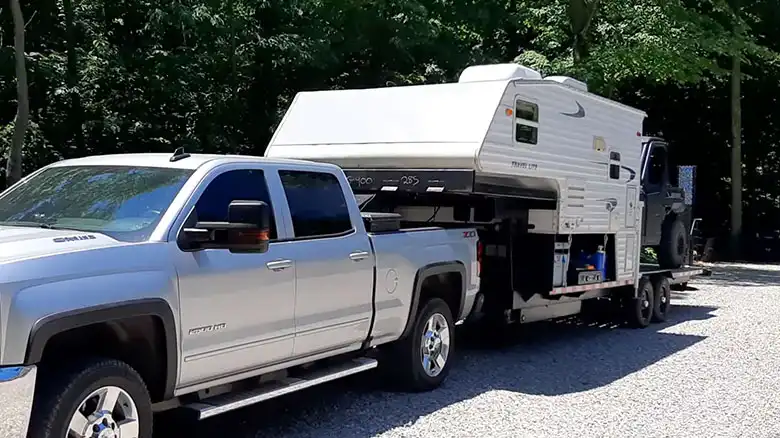
Preparing the Truck Camper to Put on a Trailer
Putting a truck camper on a trailer requires careful preparation of both the camper and the trailer to ensure a safe and successful loading process. Proper measurements, securing techniques, and bracing are key to stabilizing the camper and preventing damage during transport.
A. Gather Necessary Equipment and Supplies
The right equipment is essential for properly fitting and securing the camper onto the trailer. Key items needed include:
Trailer rated for camper weight- The trailer must have the appropriate weight capacity to safely hold the truck camper. Overloading can lead to instability and mechanical failures.
Tie down straps and ratchet straps- These are used to firmly secure the camper to the trailer bed to prevent shifting or bouncing during transport. Both rope tie downs and heavy-duty ratchet straps are recommended.
Wheel chocks- Chocks help immobilize the trailer wheels both during loading and transport. This provides added stability when moving the camper onto the trailer.
Leveling blocks or boards- Levelers allow you to adjust for any unevenness in the trailer bed when positioning the truck camper. This helps keep the camper level.
B. Prep the Truck Camper
Before loading the camper, it’s important to configure it properly:
Empty holding tanks- This reduces weight and allows for easier maneuvering when situating the camper on the trailer. Every pound counts when trying to avoid overloading.
Retract slide-outs- Any pop-out sections need to be retracted to reduce the camper width for loading and transport. Extended slide-outs can also lead to structural damage.
Disconnect propane and electrical- All propane tanks should be turned off and any electrical hookups disconnected before loading. This helps prevent leaks or hazards.
C. Prep the Trailer
The trailer itself also needs proper preparation:
Inspect tires and brakes- Check that the tires are properly inflated with adequate tread depth. Ensure all brakes are in good working order. This helps prevent failures during transport.
Level trailer- Use built-in jacks or blocks to level the trailer side-to-side and front-to-back. This provides a flat surface for loading.
Chock wheels- With the trailer leveled, chock the wheels to prevent rolling. The trailer needs to remain stationary during camper loading.
D. Measurements and Dimensions
Taking accurate measurements helps ensure proper fitting of the camper onto the trailer:
Truck Camper Dimensions- Measure the length, width, and height of the specific truck camper. This allows alignment with the appropriate trailer size to avoid overhang issues.
Overhang Considerations- Too much overhang from the trailer can create instability. The camper length should ideally not exceed the trailer bed by more than 12 inches.
Center of Gravity- Identify the center point along the length of the camper. Positioning this spot centered over the trailer axles helps balance the load distribution. Proper weight balance minimizes swaying or fishtailing during transport.
E. Securing the Truck Camper
With the camper situated properly on the trailer, the next critical step is thoroughly securing it:
Position camper centered on trailer- Make sure the camper is centered side-to-side on the width of the trailer. Front-to-back, the center of gravity should align evenly over the axles.
1. Tie-Down Systems
Overview of tie-down systems- Rope tie downs, ratchet straps, chains, or a combination can be used. Attach these at anchor points along the trailer frame.
Install tie downs at front and rear- Position rope or strap tie downs at both the front and back of the camper. This prevents forward or backward shifts.
Attach ratchet straps over camper- For extra hold, place heavy ratchet straps over the camper body. Slowly tighten to apply even downward pressure.
Choosing the right system- Use tie downs rated for the camper’s weight. Space them out appropriately to distribute force. Improper tie-downs can bend or warp the camper frame.
Chock trailer wheels- Keep the wheel chocks in place after loading to prevent rolling.
Retract stabilizing jacks- Don’t forget to lift and secure any stabilizer jacks extended for loading. These should be fully retracted before towing.
2. Bracing and Support
Properly secure camper corners- Use corner braces or padded supports to hold the camper edges in place so they don’t shift side-to-side or bounce during transport.
Ensure campers are level side-to-side- Improper side-to-side angle puts strain on tie-downs. Re-check levelness after securing.
Prevent movement and damage- Tie downs that are too loose can still allow the camper to sway, twist, or bounce, causing structural damage over time.
F. Transporting the Loaded Trailer
When towing a trailer with a camper properly loaded, be sure to follow these guidelines:
Attach safety chains- Chains provide an emergency backup connection between the trailer and vehicle. Cross the chains underneath the tongue in an X-pattern.
Connect trailer lights- Plug in the trailer lighting connector to make brake lights, turn signals, and running lights operational. Test them before towing.
Check tire pressure- Inflate the trailer tires to the manufacturer’s recommended pressure rating to improve stability under the heavy load.
Keep speed under 65 mph- Higher speeds can cause sudden swaying or lurching when towing a camper-loaded trailer. Take it slow.
With the right preparations and proper securing techniques, transporting your truck camper on a well-matched trailer can be done safely and efficiently. Always place stability and damage prevention above speed or convenience when loading your camper onto a trailer. Take it slow, double-check your tie downs, and enjoy the views ahead from your rolling home away from home!
Selecting the Right Trailer to Put a Truck Camper On
Choosing the best trailer for hauling your truck camper requires matching the trailer’s specifications and capabilities to the size and weight of your particular camper model. Considering the trailer type, capacity ratings, and features will help ensure safe and stable transport.
A. Trailer Types
There are two main options when selecting a trailer for truck campers:
1. Flatbed Trailers
Advantages- Flatbeds provide a wide open bed for loading oversized or heavy campers. They allow tie downs to be secured anywhere along the bed frame.
Disadvantages- Less protection from road debris and elements during transport. Loading/unloading requires more lifting.
Suitable for bigger campers- Flatbeds can accommodate large, heavy truck campers that exceed utility trailer weight limits. Their open design also allows any camper overhang.
2. Utility Trailers
Features- Utility trailers offer more enclosed space with sides/roof for protection during transport. Some models have ramps for rolling campers on and off.
Limitations- Utility trailers often have lower weight capacities than flatbeds. The enclosed sides limit overhang space and tie-down options.
Good for smaller campers- Light-duty utility trailers are best matched with smaller, pop-up truck campers that fit entirely within the bed space.
B. Trailer Capacity Considerations
A major factor in trailer selection is ensuring its capacity matches the truck camper:
1. Weight Rating
– The trailer’s gross vehicle weight rating (GVWR) must exceed the total loaded weight of the camper. Exceeding the rating risks damage or loss of control.
– Weigh your truck camper on a scale when fully loaded with cargo, water, propane, etc. Select a trailer with a GVWR well above the measured weight.
2. Axle Configuration
– For heavier campers, a dual-axle trailer provides better weight distribution and stability during transport compared to a single-axle.
– More axles also allow better adjustment of tongue weight and balance over the trailer wheels to minimize sway.
Matching your particular truck camper’s measurements and weight to the appropriate trailer model ensures reliable, incident-free transport. Always leave a safety margin on capacity to account for any additional cargo or trailer loading.
Loading Process of the Trailer to Put with Camper
Loading a camper properly onto a trailer requires careful alignment, a methodical securing process, and testing for stability. Following recommended steps will help the loading go smoothly and safely.
A. Loading Techniques
1. Alignment
– Align the camper centered side-to-side over the trailer bed. The camper should be positioned with a maximum 2 feet of overhang front and back.
– Front-to-back, the center of gravity of the camper needs to be directly over the trailer axles. This balances the weight evenly and minimizes swaying from tongue weight.
2. Guidelines for a Safe and Efficient Loading
– Inspect and prep the trailer and truck camper as outlined in the preparation section. Back the trailer in a straight line up to the camper. Leave just enough room to attach tie downs. Extend the front camper jacks to raise the front of the camper bed above the trailer height. Back the trailer slowly under the raised camper. Align the camper centered on the trailer both side-to-side and front-to-back. With the camper aligned, lower it gently until it rests securely on the trailer bed. Install tie downs at the front and rear frame. Tighten adequately to remove any slack. Attach ratchet straps over the top of the camper, tightening gradually in a crisscross pattern. Confirm the camper is centered and resting evenly on the trailer bed. Add load-leveling boards anywhere needed. Carefully retract the stabilizing jacks, ensuring no binding that could damage the camper frame. Confirm tie downs are tight and secure. Rock the trailer to check for any swaying or shifting.
B. Loading the Camper
When the positioning and tie-down process is followed methodically, the physical work of loading the camper is straightforward:
– Line up the backed trailer evenly with the raised/supported camper.
– Using the jacks, or front winch on a flatbed, gently lower the camper onto the prepared trailer.
– With the weight now on the trailer, disconnect the camper hitch, chains, and electrical from the truck.
C. Adjustments and Testing
Before towing, a few final checks help ensure stability:
1. Suspension Alignment
– The added camper weight may compress the trailer springs. Inspect for correct suspension alignment and adequate clearance.
– Improper suspension adjustment can cause the loaded trailer to bounce or sway. Load-leveling bars or airbags can help balance the load.
2. Stability Testing
– Rock the trailer to check for any shifting or loosening of tie downs. Test braking and lights.
– After the first few miles, stop and re-confirm the tightness of straps and secureness of the camper.
Following proper step-by-step procedures for alignment, securing, and testing during camper loading minimizes the risks of problems arising down the road. Taking it slowly with safety checks along the way will get you and your truck camper safely to the campsite.
D. Unloading the Camper
When you reach your destination, carefully unload the camper by:
– Unhook tie downs, retract ratchet straps, and disconnect safety chains and trailer lighting.
– Use the trailer’s front jack or use blocks to slowly raise the front of the camper to clear the trailer as you pull forward.
– Center the camper as you lower it onto the truck bed. Make sure you have adequate room to avoid scraping.
Legal and Safety Considerations When Putting a Camper on a Trailer
Towing a trailer with a loaded camper requires compliance with regulations, proper preparation for maintenance needs, and safe driving habits. Following the law and using common sense helps ensure the safety of both the driver and other motorists.
A. Regulations and Permits
1. Weight Limits and Compliance
– Vehicles and trailer loads must not exceed the established gross vehicle weight rating (GVWR) and gross combined weight rating (GCWR).
– Oversized or overweight camper and trailer combinations may require special permits for transport on public roadways.
2. Proper Lighting and Visibility
– Trailers are required to have functioning tail lights, brake lights, turn signals, clearance lights, and reflectors.
– For oversize trailer loads, special extended side marker lights may be needed. Amber caution lights also help alert other drivers.
B. Roadworthiness and Preparation
1. Inspecting the Trailer’s Tires and Brakes
– Examine tire tread depth, inflation pressure, and overall condition. Unroadworthy tires can suffer blowouts under the increased load.
– The surge brakes, electric brakes, or hydraulic brakes must provide reliable stopping power for the combined weight of the trailer plus camper.
2. Emergency Preparedness
– Bring along extra lights, wheel chocks, jacks, and basic tools in case issues arise while towing.
– Identify places to pull over every few hours driving in case adjustments or repairs become necessary.
– Knowing the proper protocols if brake failure or blowouts were to occur. Practice correctional slowing and stopping techniques in low risk areas.
Driving defensively and maintaining safe speeds while properly equipping your tow vehicle and trailer help keep the transport of your camper worry-free. Follow the law, use common sense, and enjoy the views!
Questions & Answers (Q&A)
1. What is the best trailer type for transporting different sizes of truck campers?
– For small to mid-sized campers, enclosed utility trailers offer protection during transport. Larger, heavier campers are better suited for heavy-duty flatbed trailers that provide more open bed space and higher weight capacities.
2. How much camper overhang past the trailer bed is safe?
– Ideally no more than 1-2 feet of overhang front and back is recommended. Too much overhang can create instability from the cantilevered weight.
3. What areas on a camper are best for tie-down strap placement?
– Attach straps at strong structural points like brackets or frame cross members. Avoid fastening to lighter exterior sides that could dent. Corner gussets and bumpers are other good tie down locations.
4. What steps should be taken if a loaded trailer begins to sway?
– Gently reduce speed and avoid abrupt acceleration or braking which can worsen sway. Activate the trailer brakes controller to help stabilize. If needed, pull off the road safely and check tie downs and weight distribution.
5. Can I tow a camper-loaded trailer with a bumper pull hitch on my truck?
– For lightweight pop-up campers a class III hitch may work, but heavy campers require a 5th wheel or gooseneck for safe towing. This places more of the trailer’s tongue weight over the truck’s rear axle.
6. How can I determine if the weight of a truck camper exceeds my trailer’s capacity?
– Weigh your loaded camper on scales at a truck stop. Add your own approximate cargo weight. Compare the total weight to your trailer’s gross vehicle weight rating to see if you are exceeding it.
7. What is the maximum recommended speed for towing a camper on a trailer?
– Most experts recommend against exceeding 55-65 mph when towing a trailer with a camper. The increased aerodynamic drag and sway at higher speeds can make stability and braking more difficult.
8. Should I remove the camper from the truck bed before loading onto the trailer?
– Loading the camper while still attached to the truck can risk overloading the back of the trailer. It’s safer to disconnect and load the camper separately to improve weight distribution.
Bottom Line
Loading a truck camper onto a properly equipped trailer expands your travel possibilities while still providing the familiar amenities of your home on wheels. Paying attention to weight capacities, tie-down techniques, regulations, and safe driving practices ensures you can get out and enjoy the open road without worry. With the right preparation and loading process, your camper can tag happily along behind you on trails to memories waiting over the horizon.

